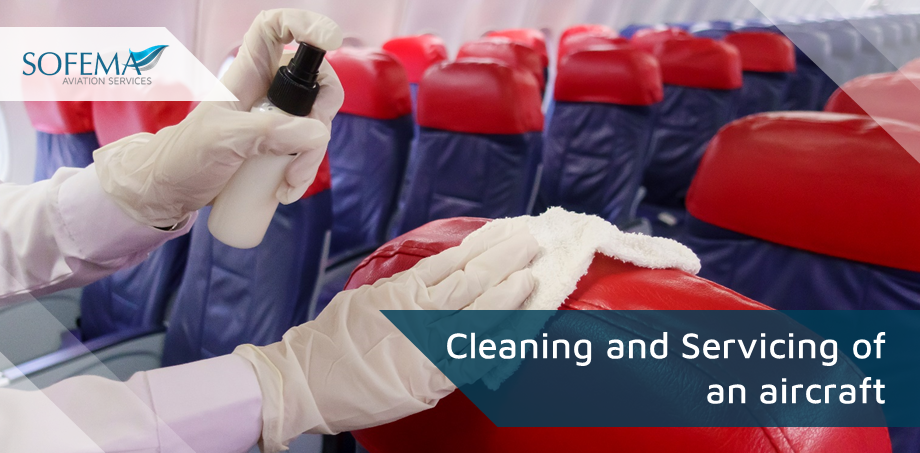Sofema Aviation Services (SAS) www.sassofia.com considers the equipment necessary to complete the Cleaning and Servicing of an aircraft including Lavatory and Potable Water Servicing
Introduction
Maintaining the cleanliness of an aircraft is a multifaceted task that requires specialized equipment and products. From ensuring the exterior is free from contaminants that could affect performance, to ensuring the interior is comfortable and safe for passengers, every aspect of aircraft cleaning is crucial. Proper training and the right tools ensure that this task is performed efficiently and effectively.
Keeping an aircraft clean is crucial for both aesthetic and functional reasons.
- Dirt and contaminants can affect the performance of an aircraft, and a clean cabin ensures passenger comfort and safety.
Aircraft Exterior Cleaning – Equipment & Tooling:
- Foam Generators: These produce a thick foam that clings to the aircraft’s surface, allowing for a more extended contact time and more effective cleaning. The foam lifts and encapsulates dirt, making it easier to rinse off.
- High-Pressure Washers: Used to remove dirt, grime, and contaminants from the aircraft’s exterior.
o They can be either electric or gas-powered. The pressure needs to be adjusted appropriately to ensure no damage is done to the aircraft’s surface.
- Telescopic Brushes: These brushes can reach higher parts of the aircraft without the need for ladders or lifts.
- Rotary Brushes: These are used for scrubbing the aircraft’s surface. They come in various stiffness levels, and care must be taken to choose the right one to avoid scratching or damaging the aircraft’s paint or surface.
- Lifts and Platforms: For reaching the upper parts of larger aircraft.
- Vacuums: For removing loose dirt and debris.
Products:
- Specialized detergents and solvents designed to clean aircraft surfaces without causing damage. They can remove grease, oil, and other contaminants. It’s essential to choose the right chemical for the job and to ensure it’s safe for the aircraft’s specific materials and paint.
- Degreasers: To remove oil and grease.
- Aluminum Brighteners: For cleaning and brightening unpainted aluminium surfaces.
- Wax and Polishes: To protect the paint and provide a shiny finish.
- Wet and Dry Vacuum Cleaners: These are used to remove water and cleaning solutions from the aircraft’s surface, especially in areas where pooling can occur.
- Microfiber Cloths and Mops: These are used for manual cleaning and wiping down the aircraft. Microfiber is preferred because it’s soft, highly absorbent, and doesn’t leave lint or scratches.
- Water Reclamation Systems: These are used to collect and treat water used in the cleaning process, especially important in areas with strict environmental regulations.
Cabin and Passenger Cleaning – Equipment & Tooling:
- Vacuum Cleaners: Specialized vacuums for aircraft interiors to clean carpets and seats.
- Upright Vacuum Cleaners: Used for cleaning carpets in the aisle and seating areas.
- Backpack Vacuum Cleaners: Allow for mobility in tight spaces, such as between seats.
- Handheld Vacuum Cleaners: Useful for spot cleaning and reaching tight spaces
- Upholstery Cleaning Machines:
o For deep cleaning of seats and other fabric surfaces.
- Disinfectant Foggers: Especially relevant in the post-COVID era, these are used to disinfect the cabin.
- Carpet Extractors: These are specialized machines that inject a cleaning solution into the carpet and then extract it, removing deep-seated dirt and stains.
- Steam Cleaners: Used for deep cleaning and sanitizing. They can be used on various surfaces, including carpets, seats, and lavatories.
Products:
- Interior Cleaners: Safe for use on plastics, metals, and fabrics found inside the aircraft.
- Disinfectants: To sanitize surfaces and ensure a germ-free environment.
- Deodorizers: To keep the cabin smelling fresh.
- Microfiber Cloths: These cloths are preferred because they can trap dirt and dust more effectively than regular cloths.
o They are used for wiping down surfaces, including tray tables, windows, and overhead bins.
- Disposable Wipes: Often pre-moistened, these are used for quick cleaning and sanitizing of surfaces.
- Mops and Buckets: Used for cleaning and sanitizing galley and lavatory floors.
- Upholstery Cleaners: Specialized solutions designed to clean seat fabric without causing damage.
- Disinfectants and Sanitizers: Especially important in the post-COVID-19 era, these are used to ensure that all surfaces are free from harmful pathogens.
- Waste Bags and Biohazard Kits: For collecting trash and handling any biohazardous waste, like used personal protective equipment or sick bags.
Lavatories Cleaning – Equipment & Tooling:
- Waste Tank Trucks: For emptying the lavatory waste tanks.
- High-Pressure Cleaners: For cleaning and sanitizing the lavatory.
Products:
- Toilet Bowl Cleaners: Specifically designed for aircraft lavatories.
- Disinfectants: To kill germs and bacteria.
- Deodorizers: To neutralize odors.
Water and Toilet Servicing Tooling and Equipment
- Potable Water Trucks: These trucks supply clean water to the aircraft.
- Water Service Carts: Portable carts that can be used to fill the aircraft’s water tanks.
- Lavatory Service Carts: These are used to empty waste from the aircraft lavatories and refill them with blue fluid (deodorant and waste breakdown chemical).
- Hoses and Connectors: Specialized hoses for both waste removal and water refill.
Next Steps
Follow this link to our Library to find & Download related documents for Free.
Please see the following training course Aircraft Servicing, Cleaning, and Detailing – 2 Days. If you have any questions or comments please email team@sassofia.com
Tags:
Aircraft, Aircraft Cleaning, Aircraft Exterior Cleaning, Aircraft Safety, Aircraft Servicing, aviation, aviation safety, Aviation Training, EASA, SAS blogs, SAS training, Sofema Aviation Services, Toilet Servicing




